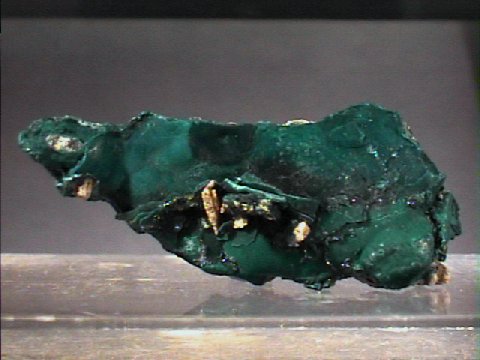 THE
MINERAL
THE
MINERAL
PSEUDOMALACHITE
- Chemistry: Cu5(PO4)2(OH)4, Copper Phosphate Hydroxide.
- Class: Phosphates
- Uses: as a very minor ore of copper and as mineral specimens.
Specimens
Pseudomalachite, as its name implies, is not malachite, but rather false malachite. It is not related to malachite at all, being a phosphate mineral while malachite is a carbonate. But there is a slight similarity in their respective formula.
- PSEUDOMALACHITE - Cu5(PO4)2(OH)4
- MALACHITE - Cu4(CO3)2(OH)4
Malachite's formula is usually written as Cu2CO3(OH)2 but if doubled, it will appear closer to that of pseudomalachite. Pseudomalachite has an extra copper to balance the extra -2 charge of the two phosphate ion groups. Both minerals have the same crystal symmetry, but different structures.
Pseudomalachite was named "false malachite" because it is visually similar in appearance to malachite. The dark green waxy botryoidal specimens of pseudomalachite are indeed reminiscent of botryoidal malachite. Both minerals are formed in the oxidation zone of copper ore deposits and are in fact associated with each other. But the much rarer pseudomalachite lacks the characteristic light and dark green banding of malachite and is slightly harder and more dense. To verify an identification, pseudomalachite will not react to warm hydrochloric acid as will malachite.
Pseudomalachite is trimorphous with the minerals
PHYSICAL CHARACTERISTICS:
- Color is a consistent dark green to blackish-green.
- Luster is vitreous to waxy.
- Transparency: Specimens are translucent to transparent.
- Crystal System is monoclinic; 2/m
- Crystal Habits include botryoidal masses and small prismatic or tabular crystals. Also found in radiating clusters, fibrous and in crusts.
- Cleavage is absent.
- Fracture is conchoidal.
- Hardness is 4.5 - 5.
- Specific Gravity is approximately 4.3 - 4.4 (above average).
- Streak is green.
- Other Characteristics: Does not effervesce with warm hydrochloric acid as does malachite.
- Associated Minerals include quartz,
malachite,
chrysocolla,
brochantite,
antlerite,
jarosite,
lepidocrocite , cornetite, atacamite and libethenite. - Notable Occurrences include Shaba, Zaire; Libethen, Slovakia; Bavaria, Germany; France; Nizhniy Tagil'sk, Russia; Canada and several localities in Arizona, USA.
- Best Field Indicators are crystal habit, color, hardness, density, localities and lack of reaction to acid.


